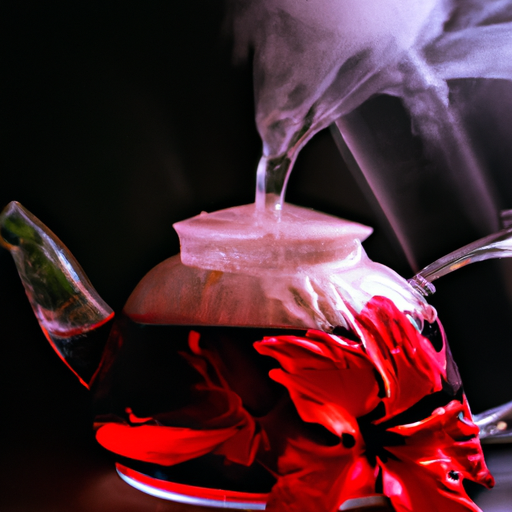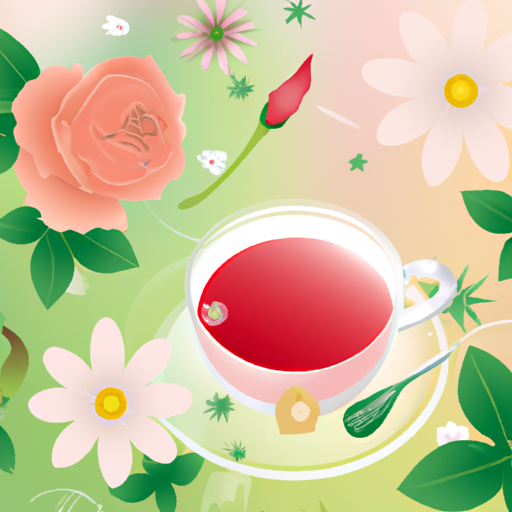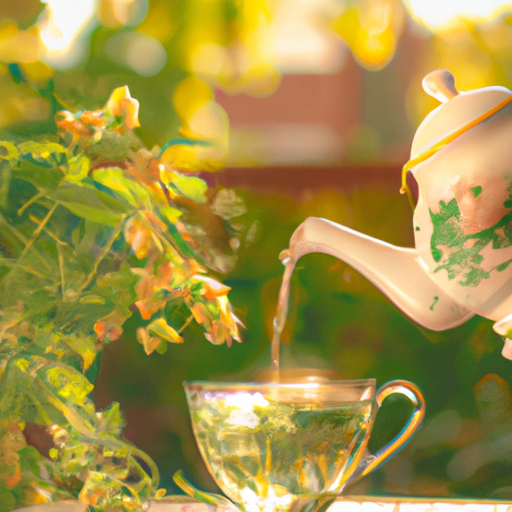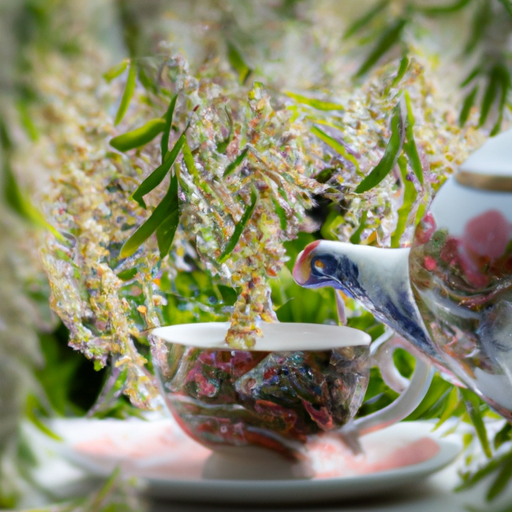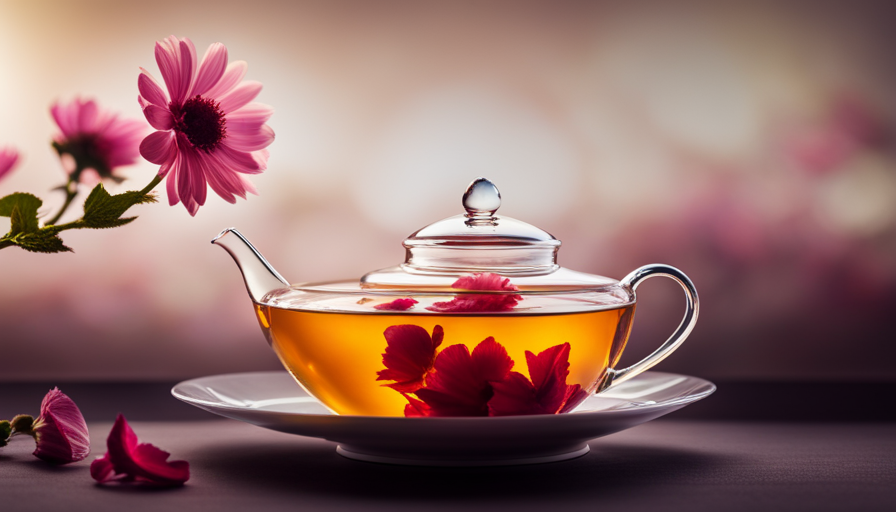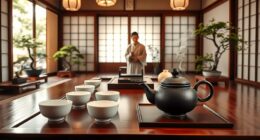Are you tired of the same old tea options? Looking for a refreshing and vibrant beverage that will tantalize your taste buds and invigorate your senses? Look no further than homemade hibiscus tea, made directly from the flower itself! Get ready to embark on a journey of flavor and wellness with this easy and satisfying recipe.
In this comprehensive guide, I will show you how to transform fresh hibiscus flowers into a delightful tea that is not only delicious but also packed with health benefits. From preparing the tea ingredients to brewing the perfect cup, I will walk you through each step, ensuring that you achieve a rich and flavorful infusion every time.
So, if you’re ready to explore the world of hibiscus tea and experience its numerous benefits, join me as we dive into this exciting and aromatic adventure. Prepare to be amazed by the vibrant colors, tantalizing aroma, and exceptional taste of homemade hibiscus tea.
Let’s get started!
Key Takeaways
- Hibiscus flowers have been used for centuries in different cultures for culinary and medicinal purposes.
- The right amount of hibiscus petals is crucial for a well-balanced brew.
- Straining the brewed tea is important for achieving a clear and smooth texture.
- Hibiscus tea can be served hot or chilled, with the option to add sweeteners and flavorings.
Gather Fresh Hibiscus Flowers
Get ready to experience the vibrant flavors of hibiscus tea as you gather those fresh, blooming flowers!
Hibiscus flowers are not only beautiful, but they also have a variety of uses. From culinary delights to medicinal remedies, these flowers have been used for centuries in different cultures around the world.
There are different types of hibiscus flowers, including the Hibiscus sabdariffa and the Hibiscus rosa-sinensis, each with their own unique characteristics and flavors. The Hibiscus sabdariffa, also known as roselle, is commonly used for making tea due to its tart and cranberry-like taste. On the other hand, the Hibiscus rosa-sinensis, also known as the Chinese hibiscus, is often used for ornamental purposes.
Now that you’ve gathered your fresh hibiscus flowers, let’s move on to preparing the tea ingredients.
Prepare the Tea Ingredients
To prepare hibiscus tea, I gather additional ingredients such as water, sweeteners, and optional flavorings. These ingredients will enhance the taste and provide a balanced flavor profile to the tea.
I carefully measure the right amount of hibiscus petals, ensuring that I have the perfect ratio for a delicious and refreshing cup of tea.
Gather additional ingredients like water, sweeteners, and optional flavorings
After gathering the hibiscus flowers, you’ll need to gather some additional ingredients like water, sweeteners, and optional flavorings. Different types of sweeteners can be used to complement the tartness of the hibiscus tea. For a healthier option, you can use natural sweeteners like stevia or agave nectar. Adding flavorings not only enhances the taste but also brings additional benefits. For instance, a squeeze of fresh lime juice can add a tangy flavor to your hibiscus tea, making it refreshing and invigorating. Lime juice is also rich in vitamin C, which boosts the immune system.
Once you have gathered all the necessary ingredients, you can move on to the next step of measuring the right amount of hibiscus petals to make the perfect brew.
Measure the right amount of hibiscus petals
Once you’ve gathered the necessary ingredients, it’s time to measure out the perfect amount of hibiscus petals for a delightful infusion. The amount of petals you’ll need depends on the intensity of flavor you desire. As a general rule, use 1-2 teaspoons of dried hibiscus petals for every 8 ounces of water. To ensure accuracy, you can use a kitchen scale to measure the petals precisely.
| Measurement | Petals |
|---|---|
| 1 teaspoon | Approximately 1 gram |
| 1 tablespoon | Approximately 3 grams |
Steeping hibiscus petals in hot water allows their vibrant color and tangy flavor to infuse the liquid. The longer you steep, the stronger the flavor becomes. Steep the petals for 5-10 minutes to achieve a well-balanced brew. Additionally, hibiscus tea offers numerous benefits for the skin, including hydration and anti-aging properties.
Now that the hibiscus petals are measured, let’s move on to brewing the hibiscus tea and unlocking its delightful flavors.
Brew the Hibiscus Tea
First, gather the vibrant hibiscus flowers and allow their rich flavors to infuse into the boiling water for a delicious and refreshing tea. Brewing hibiscus tea involves specific techniques to ensure the best flavor and health benefits.
After measuring the right amount of hibiscus petals, add them to a pot of boiling water. Let the petals steep for about 10-15 minutes, or until the water turns a deep red color. This process allows the water to extract the vibrant flavors and beneficial compounds from the petals.
Hibiscus tea is not only tasty but also packed with antioxidants, vitamin C, and minerals, which can promote heart health, lower blood pressure, and support the immune system.
Once brewed, strain the tea into a cup and serve it hot or chilled, depending on your preference. Transitioning to the next step, straining and serving the tea is crucial for achieving the perfect cup of hibiscus tea.
Strain and Serve
To truly savor the essence of this vibrant infusion, gently pour the richly colored liquid through a fine mesh strainer and into your favored vessel, allowing the aromatic elixir to cascade with grace. Here are some different ways to strain and serve your hibiscus tea:
-
Use a tea infuser: Place the hibiscus flowers in a tea infuser and let it steep in hot water. Remove the infuser and pour the brewed tea into your cup.
-
Cheesecloth method: Line a strainer with cheesecloth and pour the brewed tea through it. This will help remove any small particles and give you a clear, smooth tea.
-
French press: Pour the brewed tea into a French press and slowly press down the plunger to separate the liquid from the flowers.
-
Serve hot or iced: Enjoy your hibiscus tea hot with a slice of lemon or pour it over ice for a refreshing summer drink.
Now that your tea is strained and ready, let’s move on to adding sweeteners and flavorings (optional).
Add Sweeteners and Flavorings (Optional)
When it comes to enhancing the taste of your delightful infusion, you have the freedom to add a touch of sweetness or a burst of flavor according to your personal preference.
Hibiscus tea is naturally tart, so adding sweeteners can balance the flavor. While traditional sweeteners like sugar or honey are commonly used, there are also alternative sweeteners that can be used, such as stevia or agave syrup, for those who prefer a healthier option.
Additionally, there are various popular flavorings that can be added to hibiscus tea to elevate its taste. Some popular choices include citrus fruits like lemon or orange, herbs like mint or basil, or even spices like cinnamon or ginger.
By experimenting with different sweeteners and flavorings, you can create a unique and personalized hibiscus tea experience.
Now, let’s move on to the next step – chilling and serving the tea cold.
Chill and Serve Cold (Optional)
Once your delightful infusion’s been jazzed up with sweeteners and flavorings of your choice, it’s time to pop it in the fridge and let it chill to perfection before indulging in the refreshing goodness of your personalized hibiscus tea experience.
To serve cold, follow these steps:
-
Pour your sweetened and flavored hibiscus tea into a glass pitcher.
-
Place the pitcher in the refrigerator for at least 2 hours, allowing the flavors to meld together and the tea to cool down.
-
Once chilled, remove the pitcher from the fridge and give it a gentle stir to ensure the sweeteners and flavorings are evenly distributed.
-
Pour the cold hibiscus tea into individual glasses filled with ice cubes and add a slice of lemon for an extra zesty touch.
Now, you can sit back, relax, and enjoy your homemade hibiscus tea, perfectly chilled and bursting with flavors.
Enjoy Your Homemade Hibiscus Tea
I absolutely love savoring the vibrant color and floral aroma of homemade hibiscus tea. It’s a truly delightful experience that adds to the enjoyment of this delicious beverage.
Additionally, I’ve discovered that hibiscus tea isn’t only a treat for the senses, but it also offers numerous health benefits. From its potential to lower blood pressure to its high antioxidant content, hibiscus tea is a wonderful addition to a healthy lifestyle.
Savor the vibrant color and floral aroma
Immerse yourself in the enchanting essence of hibiscus tea as you savor its vivid color and delicate floral aroma. The vibrant red hue of the tea is a feast for the eyes, while its fragrance transports you to a garden filled with blooming hibiscus flowers.
Not only is hibiscus tea visually appealing, but it also offers a multitude of flavorful recipes that can be enjoyed both hot and cold. From refreshing iced teas to cozy herbal blends, hibiscus tea is a versatile beverage that can be customized to suit your taste preferences.
Additionally, hibiscus tea is known for its relaxation properties, making it the perfect choice for winding down after a long day. Discover the health benefits of hibiscus tea and how it can enhance your well-being.
Discover the health benefits of hibiscus tea
Now that we’ve explored the vibrant color and floral aroma of hibiscus tea, let’s delve into its numerous health benefits.
This crimson-colored herbal infusion has been the subject of numerous research studies, and the findings are truly fascinating. One of the most notable health benefits of hibiscus tea is its potential to lower blood pressure. Several studies have shown that regular consumption of hibiscus tea can help reduce systolic and diastolic blood pressure levels.
Additionally, hibiscus tea has been found to have antioxidant properties, which can help protect the body against oxidative stress and inflammation. Furthermore, preliminary research suggests that hibiscus tea may have a positive impact on cholesterol levels, helping to lower LDL (bad) cholesterol.
With these exciting findings, it’s no wonder that hibiscus tea has gained popularity as a healthy beverage choice.
Frequently Asked Questions
How long does it take to gather fresh hibiscus flowers?
Gathering fresh hibiscus flowers is as swift as plucking cherries from a tree. It takes merely a few minutes. To preserve them, dry the flowers in a well-ventilated area for several days.
Can I use dried hibiscus flowers instead of fresh ones?
Yes, dried hibiscus flowers can be used as a substitute for fresh ones in making hibiscus tea. They retain their health benefits, such as antioxidant properties and potential blood pressure-lowering effects.
Are there any specific tea ingredients that can enhance the flavor of hibiscus tea?
To enhance the flavor of hibiscus tea, I suggest adding a touch of citrus, like a squeeze of lemon or lime. This can complement the tartness of the hibiscus and create a refreshing flavor profile. Additionally, tea pairing suggestions include pairing hibiscus tea with ginger or mint for added depth. Apart from its delicious taste, hibiscus tea offers numerous health benefits, such as lower blood pressure, improved heart health, and antioxidant properties.
How long should I let the hibiscus tea brew for optimal taste?
To brew hibiscus tea for optimal taste, steep the tea for 5-10 minutes in hot water. For enhanced flavor, consider adding ingredients like lemon, ginger, or honey. Experiment with brewing times and ingredient combinations to find your preferred taste.
What are some popular sweeteners and flavorings that can be added to hibiscus tea?
Popular sweeteners and natural flavorings that can enhance the taste of hibiscus tea include honey, agave syrup, stevia, and lemon. These additions provide a touch of sweetness and a refreshing citrusy flavor that complements the tartness of the hibiscus.
Conclusion
In conclusion, making hibiscus tea from fresh flowers is a simple and enjoyable process. By following the steps outlined, you can create a delicious and refreshing beverage that’s packed with antioxidants and other beneficial compounds. The addition of sweeteners and flavorings, like honey or lemon, can enhance the taste to suit your preferences.
And for an extra special treat, chilling the tea and serving it cold is a fantastic way to beat the heat on a hot summer day. So go ahead and give it a try, and prepare to be amazed by the delightful flavors and health benefits of this amazing homemade hibiscus tea!

